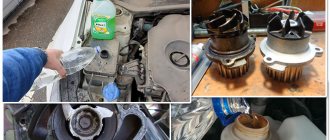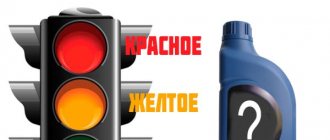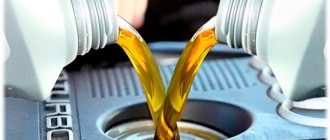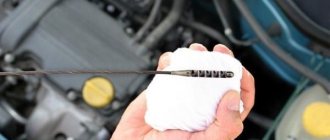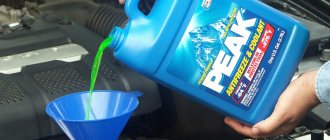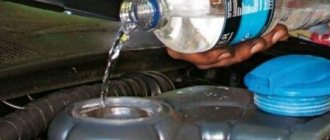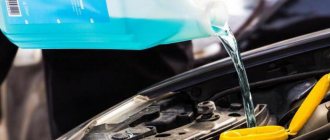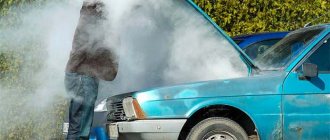What is the difference between antifreeze and antifreeze and can they be mixed?
Antifreeze or antifreeze, which is better to use in the engine cooling system? What is the difference between antifreeze and antifreeze, and how to distinguish them from each other? Is it possible to mix antifreeze with antifreeze, and what happens if you mix them? You will find answers to these and many other questions about car coolants in our article.
There are really a lot of myths about what is best to put into the cooling system. Therefore, it is very difficult for an ordinary car enthusiast to find the truth in the mass of contradictory information that has accumulated on the Internet. We will try to help you with this and debunk all the myths about antifreeze and antifreeze.
First, we suggest finding out the difference between antifreeze and antifreeze, and then we recommend watching the video at the end of the article - this will help you better understand what you read.
Instructions for replacing antifreeze in the engine cooling system can be found here; you may find it useful.
Characteristics of antifreeze
In principle, antifreeze is antifreeze made using special technology. It contains a large number of other chemicals. The name antifreeze appeared in the USSR. It stands for:
ATTENTION! A completely simple way to reduce fuel consumption has been found! Don't believe me? An auto mechanic with 15 years of experience also didn’t believe it until he tried it. And now he saves 35,000 rubles a year on gasoline! Read more"
- T - technology.
- O - organic.
- C - synthesis.
- OL is a separate laboratory.
Antifreeze was poured as a coolant into Soviet-made cars with a cast iron block. It provided several positive factors :
- Corrosion protection.
- Powerful heat dissipation.
Such engines heated up much less when compared with the heating temperature of modern engines. Today's cars are equipped with radiators and cooling system parts made of light alloy material. When it comes into contact with antifreeze, corrosion appears on aluminum parts. That is why the answer from experts to the question of whether it is possible to mix antifreeze with antifreeze in modern cars always sounds the same - it is impossible.
Antifreeze has several serious disadvantages. It forms a thick film (0.5 mm) on metal walls. As a result, heat transfer becomes minimal. Fuel consumption begins to increase, and engine parts wear out much faster.
To avoid breakdowns, experts recommend a complete change of antifreeze after 35,000 km. The disadvantages of antifreeze include inorganic salts included in the liquid. Various silicates, together with phosphates, precipitate. The radiator begins to become clogged, and the system must be cleaned periodically.
Is it possible to add water to antifreeze and antifreeze?
Mixing antifreeze and antifreeze with distilled water is permissible, since the coolant contains about 70% of it! But a change in concentration changes their properties towards a worsening of the freezing threshold, which in severe frosts can cause breakdowns in the form of a broken engine, radiators, and damaged pipes.
Even not frozen, but crystallizing antifreeze can cause a radiator leak. Adding water can only be justified if it evaporates, which changes the composition of the liquid towards increasing density. This should be done by first draining the antifreeze from the engine into a container and pouring it back into the system after mixing.
What is the difference between different colors of antifreeze?
What is the difference between antifreeze of blue, green, red colors and brands G11 and G12?
To understand the question of what kind of coolant can be filled, and whether mixing them is allowed, it is worth knowing the features of antifreeze types G11 and G12.
Here's what you need to know:
G11.
Inorganic antifreezes are called glycol. The liquid base contains corrosion inhibitors that form a protective film on the inside of the engine elements.
Such additives are useful in cases where the coolant comes into contact with non-ferrous metals.
If there is no protective film on the surface, then the metal is destroyed due to the action of the glycol base.
G11 compounds last for 2-3 years, after which they require replacement.
The first representative of such antifreeze was a coolant called VW coolant G11 (manufactured by Volkswagen).
At the present stage, the company produces “hybrid” coolants under this brand, which are produced according to the following specification - VW TL 774-C.
As for other manufacturers, they follow the path of the founder, but it is not always possible to strictly follow the stated requirements.
Thus, the original G11 antifreeze does not contain phosphates, amines or borates.
As for G11 coolants from other manufacturers, they usually contain these additives. The color of the products is most often green.
G12.
Coolants that belong to the category of carboxylate antifreeze.
The already mentioned Volkswagen company previously released the product VW coolant G 12, after which it developed a specification corresponding to the new coolant (its name is VW TL 774-D).
Unlike the G11 discussed above, the twelfth type has a different effect on the motor.
It is no secret that modern power units are made without the use of copper and brass, and the main sources are steel and aluminum.
During operation, corrosive films are created on the surface of these metals, which lead to gradual destruction of engine parts.
Additives in G12 eliminate the appearance of such deposits. The new technology used in the production process is called Long Life. The advantage is that the coolant lasts longer.
But you can completely switch to a new composition only if there are no non-ferrous metals in the engine. Otherwise, G12 additives will destroy the surface.
The color G12 is usually red (less often yellow).
Is it possible to mix antifreeze with water?
Since antifreeze contains a significant amount of water, if you add water to antifreeze, nothing bad will happen. Dilution simply occurs and concentration decreases. The more water you add, the worse the antifreeze properties will become.
We recommend: Insulating yourself for the winter - choosing the best option for a car blanket
But sometimes it is recommended to add water to antifreeze. This approach is used when antifreeze has boiled, causing water to evaporate and the remaining liquid in the cooling system to become highly concentrated. But when adding, you need to know the proportions. Excessive amounts of water will cause rust to appear in the cooling system.
Attention: mixing water with antifreeze is only possible in summer. At sub-zero temperatures, such diluted coolant can quickly seize and freeze.
If such antifreeze freezes, you will have to invest in repairs in the car components. Usually, when the coolant freezes, the radiator of the stove and engine ruptures, as well as pipes burst and hoses crack.
Even if the antifreeze was boiling and it became highly concentrated, it is better to add antifreeze of the same class and brand. In winter, it is safer to operate the car with high concentration antifreeze.
The conclusion about adding water to antifreeze is this: if you had to add water, then add a little.
When adding antifreeze, add only antifreeze of the same class that was added previously (G11, G12, G12+, G13) and the same color. Antifreeze class G-13 is based on propylene glycol.
What is better antifreeze or antifreeze
It is not possible to say unequivocally that antifreeze or antifreeze is better. Each liquid has its own pros and cons. Each is recommended for use in certain vehicles.
Antifreeze class G12 (red), which contains carboxylic acid, exhibits excellent properties when working in copper and brass radiators. The greatest protection for aluminum radiators is provided by class G11 (green) fluids and antifreeze.
An important point when choosing a coolant. Antifreeze itself is colorless. The blue, red, green, yellow color of the coolant is achieved by adding dyes that do not perform any functions.
Color matching to a specific class is generally accepted, but not permanent. You need to understand that color is not a determining factor when choosing a liquid. It is the classification on the label that will help you choose the coolant needed for your car.
Is it possible to mix coolants with different characteristics?
To figure out whether it is possible to mix coolants g11, g12 and g13, it should be noted that the first two types of antifreeze are included in the same subgroup, and G13 is a fundamentally different composition. A mixture of liquids g11 and g12 will retain protective and anti-corrosion properties, but it must be borne in mind that the mixing process is uncontrollable and it is difficult to accurately predict what the final composition of the additives will be (in this case, no sediment will form). It is also worth noting that when mixing different compositions, you can get a coolant that contains additives that are undesirable for a particular engine model or radiator design. In this case, the efficiency of the cooling system will decrease.
Is it possible to mix TOSOL and antifreeze?
Another frequently asked question is, is it possible to mix antifreeze and antifreeze? Since, again, we found out that antifreeze is a type of antifreeze, it would be more appropriate to ask whether it is possible to mix antifreezes with each other?
Important! It is worth knowing that you should not mix different coolants with each other unless absolutely necessary. Even having a similar composition, they may not match in some ways (for example, the quality of additives), so the quality of the mixture will be worse than the quality of each of them separately. Therefore, you can add another coolant only in extreme cases and a little at a time. But pouring in whatever comes to hand without understanding what is in the tank is downright dangerous. Conflicting additives can turn the liquid into a gel or form a heavy sediment.
You can also come across harmful advice to add antifreeze according to color. This is incorrect, since color is just a choice of the manufacturer and does not mean belonging to any category. The only thing you need to be guided by when choosing a top-up is technology and composition.
Antifreeze G11 can be mixed with the same or antifreeze, with a hybrid. Carboxylate - mix with carboxylate. Under no circumstances should carboxylate antifreeze be mixed with traditional antifreeze or antifreeze!
What does the color of antifreeze mean?
I think we have sorted out the additives and types of antifreeze. But what about the different colors of antifreeze? Do they affect anything? In this case, a reservation should be made. Several years ago, very strict accounting was introduced, when different types of antifreeze were added their own color in a strict order. Manufacturers kept records of all types of coolants produced and assigned them the required shade.
Confusion arose with the emergence of more and more manufacturers who did not take into account the existing rules established by such large players as Volkswagen, Mercedes, Volvo and so on. The abundance of green antifreezes brought confusion to the existing system, and therefore focusing on color as a specific type has not worked for a long time. And the color itself became a necessary convention. However, if you come across old samples of antifreeze, you can determine the desired antifreeze by color. G11 is green, G12 is red, G13 is brown or purple. But you can’t trust colors alone - consider the composition and active elements.
Is it possible to mix different brands of antifreeze, for example G11 and G12?
Despite the presence of opponents of this method, and people who do such manipulations without hesitation, a clear opinion has formed on the network, which has a detailed definition of the consequences of mixing different brands with each other.
According to these data, mixing G11 with any other analogues (including G11 itself) is acceptable, except for G12. It (G12) can only be mixed with similar and G12+. Antifreeze types G12+, G12++ and G13 are fully compatible with each other and with G11.
Difference between antifreeze and antifreeze
What is the difference between antifreeze and antifreeze, and how can they be distinguished from each other?
- Antifreeze is the international name for coolants for engine cooling systems (required reading: a great educational program on antifreeze).
- Antifreeze is also antifreeze, only domestically produced. It is no worse or better than other coolants.
The word “antifreeze”, in fact, is an abbreviation of the name of the department “Technology of Organic Synthesis” (abbreviated as TOS) of the Research Institute of Organic Chemistry and Technology, where it was developed in 1971. The ending “OL” indicates that it belongs to the group of alcohols.
In those days, no one thought to patent the name “antifreeze” and now it is used by many domestic antifreeze manufacturers. Today, not a single manufacturer produces antifreeze according to the recipe of that very real Soviet “Antifreeze”.
We recommend: Troubleshooting the fuel gauge
This is neither good nor bad, it’s just that manufacturers use a name popular among car enthusiasts for marketing purposes. Therefore, in most cases, under the Tosol brand, you can purchase high-quality antifreeze for the engine cooling system. The main thing in this matter is to choose a trusted manufacturer, and not to buy the first canister you come across with the inscription “Antifreeze”.
Antifreezes are divided into mineral (class G11), organic (class G12) and lobrid (class G12++ and G13) - the difference between them lies in the base used and additives.
- Antifreeze is a mineral antifreeze. Its service life is 50,000 km or 2 years of operation.
- Organic antifreeze can be used for up to 5 years or 250,000 km.
- And lobrid antifreezes are compatible with any other coolants for cars, and they can be safely added to new engines.
Antifreeze is more used in domestic cars. Antifreeze and antifreeze have the same base - ethylene glycol, but their density is different. Therefore, one hydrometer is used to measure the density of antifreeze, and another is used for antifreeze.
Antifreezes and antifreezes are distinguished according to certain parameters:
- Boiling point;
- Freezing temperature;
- Anti-corrosion properties;
- Lubricating properties.
Coolants are available in colors such as green, blue, yellow and red. This is achieved through the use of dyes.
We have figured out the difference between antifreeze and antifreeze, now we can move on to the next common question among car enthusiasts.
Differences between antifreeze and antifreeze.
Today, three types of coolants for internal combustion engines are used: water (distilled or pure rainwater), antifreeze and antifreeze.
Antifreeze is the name of the liquid (translated as “anti-freeze”) for the engine cooling system, which does not freeze and can withstand high temperatures.
Standard composition of antifreeze for cars:
- Water.
- Ethylene glycol.
- Glycerol.
- Alcohol.
- Acid salts or carbonate additives.
Composition of antifreeze:
- Water.
- Anti-corrosion additives.
- Burates and phosphates.
- Alcohols.
- Glycols.
- Nitrites.
- Silicates.
- Nitrates.
Differences:
- antifreeze was invented later than antifreeze;
- Antifreeze is better in terms of environmental friendliness;
- The boiling point of antifreeze is higher;
- The freezing point of antifreeze is lower;
- Antifreeze provides better protection against corrosion.
- Antifreeze forms a protective film, but antifreeze does not, and therefore antifreeze cools much more efficiently.
- The service life for which antifreeze is designed is 6 times less than that of antifreeze.
- antifreeze protects engine cylinder liners from cavitation (air bubbles).
- The service life of the pump (pump) is significantly reduced if antifreeze is used.
- antifreeze does not clog radiators, and various types of deposits do not form.
The main disadvantage of antifreeze is that when heated to 105 degrees, its properties deteriorate.
Antifreeze boils when heated to 115 degrees and does not leave sediment in the channels and can be used for up to 250,000 km.
Coolant Differences
Many car owners are interested in whether it is possible to mix antifreeze with antifreeze so that there are no negative consequences. This is only allowed in emergency situations. After all, these liquids have several characteristic differences that affect engine operation:
- Antifreeze, it's just a brand. Antifreeze, the general name for all coolants.
- Antifreeze contains inorganic salts. Coolant contains only organic substances.
- Antifreeze can be used for no more than 40,000 km. The coolant is designed for 200-250 thousand km.
- The coolant only protects areas where corrosion is likely to occur. Withstands heating up to 115 degrees.
Specialized stores offer a wide range of coolants and oils. They all differ in their characteristics and scope .
- G11 - mineral water.
- G12 - organic.
- G12++ - universal fluids.
- G13 - propylene glycol coolant.
Ordinary antifreeze is considered mineral antifreeze. Foreign coolants have an organic basis.
What is the difference between antifreeze and antifreeze
All car coolants are based on a mixture of ethylene glycol and distilled water , which determines their basic properties - a low freezing threshold and a boiling point of about 100 ° C. The main difference lies in the additive package:
1. Antifreeze is a type of coolant produced by domestic manufacturers according to traditional technology. It contains ethylene glycol and water with additives of inorganic acids. The liquid is intended for cooling systems of domestic cars and loses its properties after heating to 105 ° C.
2. Antifreeze is a liquid produced by foreign manufacturers using carboxylate technology. In addition to water and ethylene glycol, it contains additives based on salts of organic acids. Compared to antifreeze, it has increased anti-corrosion, anti-cavitation and anti-foam properties. It is successfully used in cooling systems of both foreign and domestic cars.
It is impossible to distinguish antifreeze from antifreeze by visual signs. Some motorists have the misconception that antifreeze only comes in a light blue shade, although it can be painted dark blue, green, and even pink. To do this, pay attention to the manufacturer of the liquid: if it is produced in Russia, then it certainly cannot have a carboxylate composition.
The difference is determined after a thorough study of the composition. Antifreeze contains nitrates, phosphates, silicates, borates and amines, and antifreeze contains additives from salts of organic acids. Liquids also differ in boiling point: domestic liquid boils after 105°C, and carboxylate – after 115°C. life of antifreeze is up to 40 thousand km, while antifreeze can be used without replacement for up to 240 thousand km.
Is it possible to mix coolants of different colors?
As a rule, antifreezes that differ in color have different characteristics. The fact is that different generations of liquids for automotive cooling systems use additives with different color shades. Modern antifreezes are distinguished by higher efficiency and environmental friendliness in comparison with those samples of auto chemicals that were produced previously. The range of coolants presented in auto stores includes hybrid, carboxylate, labrid, as well as traditional antifreezes. They differ in composition, characteristics and color. To understand the differences, you should consider their main properties, which are of particular importance when used in internal combustion engine cooling systems:
- Anti-corrosion characteristics . Conventional antifreeze does not protect engine parts associated with the cooling system from corrosion. At the same time, red or purple coolant provides reliable protection of engine components for a long time.
- Boiling point . Coolants with higher boiling points better protect the engine from overheating under extreme loads. Blue and green antifreezes boil at temperatures between 102 °C and 110 °C. If we consider that for many modern engines the average operating temperature reaches 105 °C –115 °C, it becomes clear that it is undesirable to use such compositions for modern cars. In this case, you should use purple antifreeze, the boiling point of which is from 135 °C to 137 °C.
- Freezing temperature . The value of this indicator should be compared with the minimum air temperature in the region where the car is operated. Standard freezing temperatures for different antifreezes range from −20 °C to -40 °C. It should be taken into account that conventional and hybrid coolants begin to thicken when they cool below 0 °C, and this makes it difficult for a cold engine to operate. According to this characteristic, carboxylate and labrid antifreezes are more preferable.
As noted earlier, the more modern the development of antifreeze, the better its functional characteristics when used in internal combustion engine cooling systems.
It is also worth noting that it is undesirable to mix coolants of different colors (even if they are antifreezes of the same type, but produced by different manufacturers). The fact is that they contain various additives that can neutralize each other’s beneficial properties, which means the characteristics of the coolant will deteriorate.
Mixing antifreezes that differ in color should only be done in exceptional situations when there is no other option. For example, any mixtures with G13 coolant can be used in modern engines, but their anti-corrosion properties will be noticeably reduced. No matter in what proportions you have to mix G13 antifreeze with other liquids for internal combustion engine cooling systems, the resulting mixture will have characteristics similar to lower category antifreezes. So, when combining G11 and G13, we obtain a liquid whose properties are the same as those of green antifreeze.
This suggests that it is worth mixing different colored coolants only if you urgently need to add antifreeze to the cooling system, but there is no way to find a suitable composition. After this procedure, whenever possible, you should flush the cooling system and fill in new antifreeze that meets the specifications provided by the automaker for a specific car brand. When using a car for a long time, mixed antifreezes can harm the engine.
It cannot be said that among the coolants of different colors produced by trusted manufacturers, there are good and bad samples. The shade of antifreeze is determined by additives that affect its properties. The choice of mixture should be made taking into account the type of engine, so it is worth carefully studying the requirements of the car manufacturer.
We recommend
“How often to change brake fluid and why to do it” Read more
What happens if you mix antifreeze with antifreeze?
Firstly, the question is why mix these two different refrigerants. Well, various circumstances happen on the road, for example, there is an antifreeze leak and after eliminating the leak, you need to add antifreeze. But there is not always a canister of antifreeze in the trunk, and here they sell antifreeze nearby on the side of the road. You have to buy it and top it up to continue moving forward.
Or, as often happens, sooner or later after buying a used car, you have to top up the coolant, and then the driver asks the question: what was filled in before? Color is easy to determine, but classes are difficult. In such cases, experts recommend, again, not to save, but to drain the old fluid and fill in the new one in full. It is even possible that the old one has expired.
But, let's look at what happens after adding antifreeze to antifreeze.
From the composition we know that they only have in common water and, perhaps, a standard (ethyl alcohol). And each manufacturer adds different additives and additives in different quantities. Therefore, when mixing antifreeze and antifreeze, a sediment may form that will settle in the channels and on engine parts, which will gradually reduce the life of the internal combustion engine. Nothing bad will happen when adding antifreeze to antifreeze if their components are basically the same, but this cannot be checked with your own hands without a chemical laboratory.
Based on the above, we conclude that if you already had to mix antifreeze and antifreeze, then upon arrival, it is better to drain this liquid, do a complete flush of the engine cooling system and fill in a new homogeneous mixture. The cost of buying new antifreeze will save you a lot of money, effort and time.
How to spot fake antifreeze
The quality of the coolant is of great importance. Non-compliance with the declared properties can result in serious problems for car owners.
A low boiling point may cause the engine to overheat.
Lack of crystallization and high freezing temperatures can damage the cooling lines, cooling radiator and cylinder block of the internal combustion engine.
When purchasing coolant, it is better to contact sellers with a good reputation who have been on the market for a long time. Having a quality certificate will reduce the likelihood of purchasing counterfeit products.
Even in this case, the buyer is not immune from counterfeiting. A few tips that can help you choose and fill in high-quality antifreeze.
The first thing you should pay attention to is the quality of the packaging and stickers. A poorly printed sticker that barely stays on or a deformed canister is the first sign of a counterfeit product.
Strong foaming of antifreeze indicates low quality . Just shake the canister. If the container is not transparent, look at the level line at the end.
All these measures are preliminary and cannot give a definite answer about the quality of the coolant. The following experiments after opening the package will help you achieve more accurate results.
Testing for Ph
This is done using litmus paper. If the acid medium indicator changes color to pink or blue after contact with coolant, it means the antifreeze is of low quality. Green color indicates the correct choice.
Measuring density
Using a hydrometer. Measurements are made on liquid at room temperature (15-20 g). Indicators in the range from 1.071 to 1.104 are the norm. It is recommended to take measurements of the new fluid after a week of use. A large difference in the results indicates density-increasing additives. It is recommended to replace the fluid.
Freezing at home
It is enough to place a small amount of antifreeze or antifreeze in the freezer. Due to the low temperature and small amount of liquid (100-150 ml), conclusions can be drawn after one and a half to two hours. If the viscosity of the fluid has not changed or crystallization has occurred, the antifreeze is of good quality.
Bring to a boil
We use a heat-resistant container. Ethylene glycol is a potent poison. Therefore, it is better to choose disposable containers. If you have a thermometer that allows you to take the necessary measurements, use it. Compare the boiling point with the stated one.
The minimum boiling limit of antifreeze is 110 degrees. If there is nothing to take measurements with, pay attention to the presence of sediment. With low-quality antifreeze, additives fall out.
Differences
However, apart from some subjective opinions from car owners, antifreeze itself and modern foreign antifreeze differ from each other in components and also in established performance characteristics during use.
Antifreeze is much more aggressive in its effect on the internal elements of the engine and on the pipes, as well as on the engine cooling systems, which is why antifreeze contains a special silicate, which, as the mixture is used, is deposited on the surface of the cooling system tubes and perfectly protects the engine from the effects of corrosion .
Antifreeze itself is much weaker in its effect on the car and for this reason it does not contain silicate. That is why mixing antifreeze with the same antifreeze or replacing antifreeze with antifreeze without first cleaning and washing the pipe system in the engine can provoke corrosion of internal elements and lead to the appearance of corrosion on the engine and other contaminants in the car’s cooling system. This can disrupt engine operation and completely damage the car within a short period of time.
It is also worth considering that different types of automotive antifreeze are based on different compositions - ethylene glycol or propylene glycol plus a list of third-party additives. In addition, you should not smell antifreeze, or even try to taste it - any antifreeze for the cooling system is poison.
Antifreezes are distinguished in such areas as performance lubricating and general anti-corrosion characteristics, including average aggressiveness towards many internal elements of the engine, such as engine seals and gaskets, as well as pipe systems for supplying the coolant mixture to the engine, also differ in freezing point and boiling point.
External (including color) differences between antifreezes are expressed in the thickness and actual shade of the mixture: on sale you can see red antifreezes, blue ones, which are rarer on the shelves, and also green ones. Antifreeze is given its tint by special additives - dyes.
The dyes themselves mean the possibility of mixing one type of antifreeze with each other from different manufacturers. It is worth considering that, for example, when mixing red antifreeze with the same red antifreeze, even from another manufacturer (although this should not be done in any case), the antifreeze will not begin to foam and sediment will not form in it.
But at the same time, based on existing reviews from car owners, most often you can not worry and calmly mix antifreezes of different shades (add one to another). In any case, no one can accurately predict the outcome of this operation.
You can, of course, drive with such antifreeze, but it is still advisable to change it as soon as possible. At the same time, what antifreeze should be purchased for replacement is a matter of your personal preference. Some try to purchase only imported antifreeze from well-known manufacturers, some prefer domestic products and do not want to overpay
Keep in mind that when purchasing antifreeze you should pay attention to its shade (if you only want to mix and add another antifreeze to your car)
